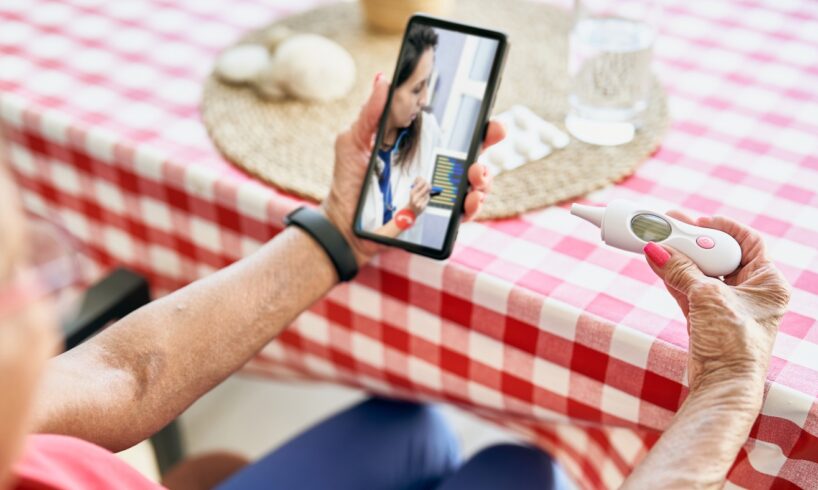
Telehealth — seeing a doctor or nurse via a videoconference on your phone or computer — got a boost during the pandemic. Telehealth payments for people on Medicare are on hold during the shutdown.
Fotografía de eLuVe/Moment RF/Getty Images
hide caption
toggle caption
Fotografía de eLuVe/Moment RF/Getty Images
A few weeks ago, when Vicki Stearn, 68, tried to schedule a virtual visit with her doctor, she was told Medicare — at least temporarily — stopped paying for telehealth appointments when the government shut down. So Stearn was offered a choice: Make an in-person appointment, or pay out of pocket for telehealth.
“So I said, ‘OK, well, when can I get an in-person appointment?’ And it wouldn’t have been until December.”
So Stearn, who lives in Bethesda, Maryland, paid — hoping that when the government reopens, she’ll be reimbursed. But Stearn, who serves on the patient advisory council for Johns Hopkins Medicine, says the loss of telehealth services complicates life for almost everyone – from the working person to Stearn’s own 90-year-old mother, who hates traveling to and from the doctor.
“When I have a cold, do you really want me to go into the doctor’s office and confer with everybody else?” Strearn says. “There are just so many different reasons why telehealth is a good idea.”
‘A continual disaster for access’
The use of telehealth in Medicare began in earnest during the pandemic and quickly became popular. Nearly 7 million people on Medicare use telehealth services every year to see their doctors, but the federal shutdown put an abrupt halt on payments covering those services. Specifically, the temporary pandemic-era allowances that have been repeatedly renewed to enable payments, could no longer be reauthorized. Without that administrative approval, Medicare patients — and their doctors — have been left in a very complicated and confusing limbo.
“It’s a continual disaster for access,” says Kyle Zebley, senior vice president of public policy at the American Telemedicine Association.
Even large hospital systems, he says, do not have a large financial cushion to be able to continue offering services without government reimbursement. Plus, there is no clear guidance that providers will be reimbursed for telehealth services during the shutdown.
Hundreds of hospitals across the country have also suspended their investments in what’s often called “hospital at home” programs, which offer more elaborate remote monitoring and care that enable patients with more serious conditions to remain at home. Zebley says those patients have been discharged or checked into hospitals if they need continued care.
Zebley says this temporary halt to telehealth services is especially frustrating, because it is expected to return, eventually, and then hopefully made permanent. It’s convenient, efficient, and beloved across the political spectrum too, he says. “There’s broad-based bipartisan support from the furthest left member of the Democratic caucus, of the furthest right member of the Republican caucus – nobody is anything other than universally supportive of maintaining these services. And yet here we are.”
Different ways to deal with the interruption
In the meantime, doctors’ offices and hospitals must decide: Do they continue to offer services, float the cost, and hope to recoup payments from Medicare later? Or, do they halt services and require patients to come in, causing a potential backlog in appointments and forcing patients in rural areas to drive long distances?
Helen Hughes, a pediatrician and director of Johns Hopkins’ telehealth services, says every Medicare provider she’s spoken with seems to be taking a slightly different approach.
During the first two weeks of shutdown, the Hopkins network of hospitals and clinicians continued to offer telehealth appointments that were already on the books. They held off on billing Medicare, though, in the hopes that they’ll be reimbursed once the shutdown ends. “Our clinicians put a charge into our electronic health record, but we’re not sending them out to Medicare,” Hughes says.
But as the shutdown has dragged on and unpaid charges stacked up, Hughes and the hospital system switched course. On Oct. 16, they informed Medicare patients to schedule any new visits in person.
Hughes says, unfortunately, many of those getting called back into doctors’ offices are cancer patients, or people who received neurology treatments — conditions for which driving can pose real challenge and physical strain.
And pausing telehealth is not as simple as turning a switch on or off, says Hughes. In the years after the pandemic, Johns Hopkins set up a centralized hub of about 16 physicians who all work remotely — and therefore can see patients over longer hours, more days of the week, and a larger pool of patients, even in rural areas.
That team has continued to work, since it also sees patients with private health insurance.
But Hughes worries the halt in telehealth for Medicare will set back progress, saying that “in this confusing environment,” when patients try to “access this type of care, and can’t … we can lose the credibility that this is a stable type of care.”





